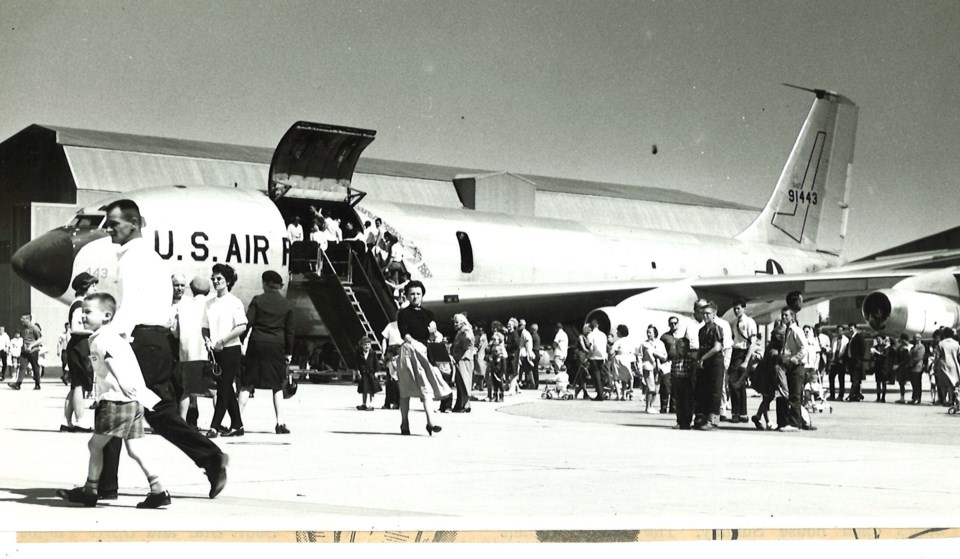From the archives of the Sault Ste. Marie Public Library:
It is hard to imagine in this day and age that one could be comforted by loud booms, shattering windows, and cracked plaster, but it was expected here in the Sault in the1960’s.
As evidenced by many articles in the Sault Star from the time period, sonic booms were becoming an increasingly frequent part of life due to the close proximity of the Kincheloe Air Force Base.
Major Kenny stated in a Sault Star article from June 2, 1962, that his men would only break the sound barrier in extenuating circumstances where it was necessary to attain maximum speed to intercept an unidentified flying object before it could be a threat to the city.
Residents were advised that since the “sonic boom is not as loud as a bomb, so when you hear it at night you can roll over and be thankful.”
He also noted that a full 50 per cent of the men stationed at Kincheloe were partially deaf which seems to discount the safety to the general public!
The Kincheloe Air Force Base was initially called Kinross Auxiliary Airfield and construction was started in 1941.
The site was selected due to its close proximity to the border and to the Soo Locks which were deemed crucial to the war effort and required protection.
The airfield was also used as a refuelling station for Alaskan-bound planes.
With the conclusion of WWII, the airfield was inactive and was used by Sault Ste Marie as a civilian airport until called into service again with the onset of the Cold War in 1947 and the Korean War in 1950.
The Cold War was a stressful chapter in world history when the United States and the Soviet Union were vying for world domination. It was described as a “Cold War” as there was thankfully no extensive direct combat between them.
Instead, the focus became nuclear weapon development, propaganda, spying, and the initiative to be the first country to get an individual to outer space.
The threat of nuclear war was always imminent and a Sault Star article from February 1958 stated that bombers from the air force base would be making regular flights over Canada armed with nuclear warheads.
The threat to civilians was minimized by military General Atkinson who said that the “threat was no greater than regular weapons, with little possibility of a nuclear explosion and that if an explosion occurred there might be some contamination, in a small area, but it would be a very small area.”
In order to get the former WWII airfield up to modern military requirements, land appropriation and large-scale construction occurred.
The development of the huge base was often compared to how quickly Elliott Lake’s planned community came together. Residences for personnel and their families would feature a design of winding streets to escape the repetitive grids of other housing projects and the base would be self-sufficient with its own school, post office, store, hospital, chapel, theatre, and even a 9-hole golf course.
In a June 1963 article in the Sault Star, Kincheloe’s deputy commander for jet interceptor operations Col. William C. Plott called Sault Ste. Marie “the first fighting line of the NORAD defence system. Our mission is detection, interception, identification, and if necessary, destruction of hostile aircraft.”
Detection was done by radar, and if interception and identification were needed, aircraft and their pilots were on constant 5-minute alert, 24 hours a day, and would be called out to approximately one “unknown” incident a week.
Tragedy struck during one of these missions to identify unknown aircraft on Nov. 23, 1953.
First Lieutenant Felix Moncla and his plane vanished (along with Second Lieutenant Robert Wilson who was working the radar) while investigating a UFO in the vicinity of the Soo Locks and Lake Superior.
This disaster came to be named the “Kinross Incident” and remains a mystery as neither pilot nor plane have ever been recovered.
Although the base was in the U.S.A., it was of great interest on the Canadian side as well. Not only did the two militaries work together to ensure the security of North America but their reciprocity showed in other ways as well.
For instance, in late March of 1958, a full contingent of fighter jets flew over the two cities so citizens could see them in action, and every Armed Forces Day Canadians would show up in droves to tour the base and see the jets up close.
The Sault Star reported that on May 21, 1963, three thousand people attended the annual Open House –half of them Canadian. So, it is no surprise that both Canadians and Americans alike were shocked in Dec. 1965 when it was announced that the base would be ceasing operations by 1970.
It was a huge blow economically to Sault Ste. Marie, Michigan, where up to 50 per cent of livelihoods depended on the base. 10,000 individuals were expected to leave the area as a result of the closure.
Luckily, the base did not completely close until 1977 and due to hard work and determination by city and state officials, local citizens and private industry, the area revolutionized itself.
It is currently the site of the Chippewa County International Airport, Kinross Correctional Facility, and the Chippewa Correctional Facility.
The former base was also used as the filming location for some of the scenes in the 1990 film, Die Hard 2 starring Bruce Willis. The need to land a 747 as well as the need for snow gave Kincheloe the opportunity to shine on the Big Screen!
Each week, the Sault Ste. Marie Public Library and its Archives provides SooToday readers with a glimpse of the city’s past.
Find out more of what the Public Library has to offer at www.ssmpl.ca and look for more Remember This? columns here
